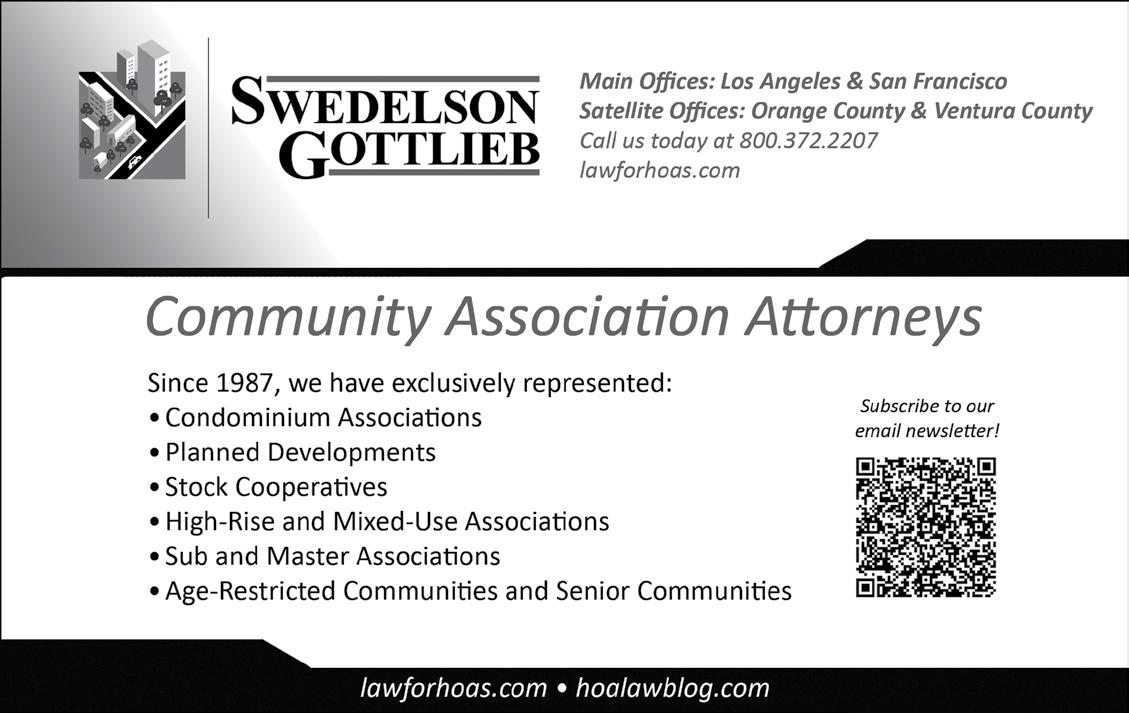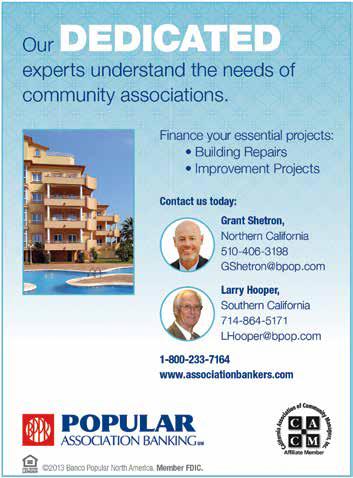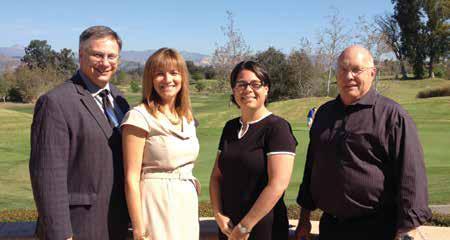
14 minute read
Spotlight on Education: The Evolution of CACM Education
The Evolution of CACM Education
The Evolution of CACM Education
Every once in a while a visionary comes along who creates something out of nothing. CACM’s founding members had a vision 23 years ago when they formed CACM – a professional association created by community managers for community managers. These bright individuals foresaw the need for career and professional support to ensure success in their field and quickly started developing the foundation to support California community managers.
From those beginning days till today, CACM has always taken pride in being the organization that is forward thinking and develops curriculum to meet the future needs of its members. We don’t just identify trends; we actually create them. Several milestones include:
Introduced the title of “community manager” in the 1990s, which is now readily accepted as the term to identify those who manage associations. In 1992, CACM proudly began offering the CCAM certification, which established core competencies and standards of practice where none previously existed.
CACM hired the Forbes Group in 2008 to conduct an environmental scan that identified aging in place as a trend with tremendous growth potential over the next 20 years. The Age-Restricted Active Adult Community Management course was created as a result to prepare members for this growing market.
In 2010, CACM introduced the first specialty course as part of a new Specialty Certificate program. This award-winning education program now allows managers to pursue specialized education and career opportunities in high rise, large scale, portfolio and new development management.
In 2012, CACM introduced the Master of Community Association Management (MCAM) certification, the highest level of mastery and expertise a community manager can attain in California.
In 2014, CACM introduced the My Community Champion public relations campaign through TV and radio spots, helping educate the more than 14 million homeowners who live in California CIDs about the importance of California-specific community management certification.
We will carry forward our proud tradition of identifying your needs and keeping you professionally competitive. For now, we’re very excited to introduce our newest offerings available in 2015:
SPC440 New Development Community Management: A new specialty course that provides an understanding of working relationships and processes employed in creating and transitioning developer controlled CIDs to owner involved associations. SPC450 Commercial & Industrial CID Management: A new specialty course that provides information and resources necessary to manage commercial and industrial CIDs and commercial sub-associations within mixed-use and industrial subdivisions.
And when you can’t come to us, we are equally proud to offer you greater flexibility than ever before in earning continuing education units. You can request courses for your area, host private offerings, or attend webinars and online courses. Developing our online offerings will be an ongoing priority, and we will announce new offerings as they become available.
Continue to let us know your thoughts and education needs. We are always listening and ready to be your onestop resource for California-specific education.

STILL NO FLYING CARS!
By Dean Jackson, CCAM
Well here we are again, looking through the crystal ball at what we hope, expect or dread in the coming years of the community management industry. Emerging trends! Sometimes we are right, sometimes not, but it’s fun to imagine.
Back in 2009 I wrote an article for the Emerging Trends issue entitled “Where are the Flying Cars?” In the five intervening years there has been some technological progress, and I have rethought some of my hopes and desires, but I still have to brave traffic every day. Here are the things I wished for back then.
Flying Cars: We still don’t have them. I’m still stuck in traffic several hours a day and it’s getting WORSE! There have been some prototypes tested in the past year or so, but nothing is coming to market. I still believe that this would save money and heartache. Fewer road repairs, less road rage, no flat tires. To be fair, there have been some advances in automotive technology. Hybrids are ubiquitous (they can even drive in their own lane!), Elon Musk has revolutionized expensive, I mean electric, cars, and even Google is getting in the act with driverless cars. So now I ask again, where are the flying cars? I’d even take a hybrid driverless flying car, or at the very least a car with puncture resistant tires or a freeway with no nails!
Video Telephones:
We’ve got them! Rest assured that between Skype
CAPTAIN KIRK HAD A COMPUTER THAT TALKED BACK, NOW SO DO I – AND SHE HAS AN ATTITUDE!
or any device beginning with “i,” we can see each other when we call. As they say, be careful what you wish for! There are some things you just can’t un-see. (A bit of advice, don’t call your brother in law before he’s had his morning coffee; I’ve had less frightful times at a horror film.) This is, however, useful technology. It enables meetings without leaving the office, as well as our brave armed forces personnel to see their families from half a world away. Now, if we could combine photo editing software with the video feed maybe we can avoid an early morning fright show.
Wrist Radios: In 2009 I suggested this was an easy fix. After all, Dick Tracy had one; all it takes is attaching a wrist band. Now we have Smart Watches! All of the stuff in our smart phones can now be on our wrists. Of course, you still need to tether to a smart phone to make it work (experience dictates that all smartphones may not be all that smart), and the devices are not quite fashion forward. Still, progress is progress.
Holographic
Communication: They have this in the movies but in the five years since I mentioned it I have not seen much progress, aside from Tupac’s surprise appearance at Coachella last year. Come to think of it, a number of late musicians are putting in holographic performances. Maybe if we put a concert promoter on this we can get quick results … that holographic board meeting can have a back beat and exorbitant ticket prices. I have, however, revised my opinion on how important this technology might be. If video calling is frightening, imagine it in 3D and with groupies!
Computers That Talk
Back: Captain Kirk had one, now so do I – and she has an attitude! Why can’t Siri just answer a simple question without being
Continued on page 42

Helping Community Associations Find Their Way
Providing practical legal solutions to common interest developments in:
• Governing Document
Interpretation and Enforcement • Contract Negotiation and Preparation • General Counsel Service • Litigation, Trial and
Appellate Advocacy
Neuland & Whitney, APC
(949) 766-4700
snarky? If I wanted snarky I could just borrow one of my friends’ teenage kids. Of course, I could change Siri’s voice to make it more interesting. Maybe an Australian guy who could offer me a beer and shrimp on the barbie? But, I’ll strike that idea for fear that my wife may think he’s a better conversationalist than me; then I’d never get my iPad back.
Food Replicators: No such luck! Wouldn’t it be nice to eliminate trans fats with a touch of a button? Wouldn’t it be wonderful to get a burger without the drive through (or fly through … still hoping)? Tea, Earl Gray, Hot – come on guys!
Push Button Work Stations: Well, now I can work standing up, sitting on a large rubber ball (no kidding) or walking on a treadmill! I understand these developments are all geared to the health conscious. George Jetson had a push button work station and I want one, too. Of course if I have one of those I’d have to get rid of my treadmill; kind of counterproductive and a bit hypocritical if I had both.
Five years have come and gone and I still can’t fly to work, I don’t want to see the person on the other end of the call, my computer has more attitude than my mother-in-law, and my “smart watch” has all the style and none of the groovy tunes of an 8 track tape player. All in all I kind of like where we are right now. While I’d like a food replicator, could it really take the place of the nicely grilled steak that I’ll be having this evening? Now, if I could get a transporter machine that would be something!
Dean Jackson, CCAM, is the General Manager at Pacific Park Plaza HOA in Emeryville.
LOOKING FOR A JOB OR A QUALIFIED CANDIDATE?
In 2014, 580 community managers posted their résumés to CACM's Career Network.
Consider this exclusive job board, designed for the California community management industry, for your next job or candidate search.
The End of an Era
Honoring Karen Conlon’s 22-year legacy at CACM
By Melinda Young, CCAM, PCAM

Part of our common life experience is the feeling of not appreciating what we have until it’s gone. While Karen Conlon, CACM’s President & CEO, is and has been appreciated by the current and past Board of Directors, looking for her replacement has been a time of great reflection on all she’s accomplished for CACM and this industry.
Six months after CACM was founded, Karen was hired as its first President & CEO in 1992. She worked out of a one-room office that was loaned to the organization by a founding Board member, Jeff Olsen. At that time, there were 27 Board members (wow!) who were committed to CACM’s principles of being “created by community managers, for community managers.” Within three years under Karen’s leadership, CACM grew into an organization with more than 600 members and a full-time staff of four.
“I was often struck by the commitment of the Board members and volunteers when they spoke about the organization and its purpose,” Karen recalls. “I could hear the passion for the industry in their voices. I was impressed by their candor because it matched my own personal belief in developing an open, honest and trustworthy organization at a time when the word ‘transparency’ hadn’t even been coined as a buzzword. We were very focused on the goals and aspirations of this young organization that pledged to self-govern and protect the rights of community managers statewide,” she says. CACM’s Board currently has 15 directors who operate under the Policy Governance® model, which was adopted in 2006 through the recommendation of Karen and other Board members. This form of governance provides for a more effective operational model and requires the Board and CACM staff to be a membership driven organization. In the past 20-plus years, Karen has worked directly with 12 different Board Chairs, guiding those individuals through the trials and tribulations of their leadership position. Safely speaking for each one of these dedicated volunteers, the role of Chair would be almost impossible without Karen’s guidance. With her dedication and the commitment of those around her, Karen has been able to continue CACM’s legacy of best practices, ethical behavior and professional
education programs. Currently, CACM offers more than 200 educational programs every year, and the membership has reached more than 2,700 members with 1,575 proudly offering their services to clients as Certified Community Association Managers (CCAMs). Karen and the CACM staff have also continued to expand educational offerings and certification programs. Over the past five years, CACM has developed Specialty Certificates in four different areas of expertise. A master’s program for managers has also come to fruition through the new Master of Community Association Management (MCAM) certification. Karen’s influence and direction has also extended beyond CACM. Her participation in legislation and our state political process has been instrumental in the protection of managers’ and management companies’ rights. One of the most notable achievements under Karen’s tenure was the passing of CACM-sponsored Assembly Bill 555 in 2002. When signed into law, the state mandated that in order to be considered certified, managers were required to meet specific educational requirements and qualifications. CACM was the organization designated to provide those requirements and administer the qualifications.
Karen’s dedication to promoting favorable legislation has continued, as CACM has been able to influence innumerable industry issues ranging from assessment increase caps to the recent revisions to the Davis-Stirling Act.
In the past two years, Karen has also been deeply involved with the development

and launch of a new branding and consumer awareness campaign for CACM. She has worked tirelessly with CACM’s PR team to establish a statewide campaign celebrating managers. “My Community Champion” is designed to reach those outside our industry who may be unaware of the efforts, dedication and commitment community managers impart in communities across California.
How will it be possible to replace Karen? Quite simply, it isn’t. Karen’s influence on CACM, as well as on community managers, management companies, service providers, legislators and others throughout California (and even the country), is immeasurable. She has pushed and carried CACM to become the organization it is today. Hers will be big shoes to fill. The great news is that CACM is positioned to step out into a new chapter, with a new CEO and new aspirations.
While her last official day will happen this year, please plan to attend CACM’s 2015 Law Seminar & Expo events in both Northern and Southern California so you can applaud Karen and her successes and welcome our new President & CEO, David Zepponi.
Here’s to an incredible and unforgettable era, Karen!
Melinda Young, CCAM, PCAM is Senior Vice President of Walters Management in San Diego, as well as Chair of CACM’s Board of Directors.
Six months after CACM is founded, Karen Conlon was hired as the organization’s first President & CEO.
CACM’s Certified Community Association Manager (CCAM) program is introduced at a breakfast event. The keynote speaker, the DRE commissioner, endorses CACM’s efforts.
1992
Karen Conlon’s Impact on CACM and the Industry
Karen begins sharing her expertise by providing training and education to various groups on corporate governance, duties and responsibilities, strategic planning, management analysis and standards of care.
1995 1997
1994
CACM’s Law Seminar debuts in San Francisco with more than 300 attendees. CACM also hires a professional lobbying firm in Sacramento to support the industry’s best interests.
1996
Karen begins serving as an Expert Witness for various depositions and trials on the subject of fiduciary obligations for CID boards; community management standards and business practices; CID architectural standards; mold and construction defect; rules and regulations; developer issues; and more.
Karen Conlon’s Impact on CACM and the Industry
CACM expands its education programs to more than 100 offerings.
Senator Barbara Lee, Chair of the Senate Committee on Housing and Land Use, appoints Karen to the DavisStirling Work Group to review and revise the DavisStirling Common Interest Development Act. California Assembly honors CACM with a formal resolution “for its important role in the enhancement of professionalism among community association managers and the common interest development community-at-large.”
2006
Karen is honored with CACM’s Lifetime Achievement Award through nominations by her industry peers and board members. She also receives her seventh nomination for the Orange County Business Journal’s Women in Business Awards.
CACM’s Specialty Certificate Program debuts, with certificates available in High Rise and Large Scale Community Management. The program now includes certificates in Portfolio Management and New Development Community Management.
CACM’s new Master of Community Association Management (MCAM) certification program debuts, offering California community association managers the highest professional recognition available in the state.
2011-2012
2002
AB 555 is signed into law, officially recognizing the CCAM designation in California. As an important disclosure initiative, AB 555 mandates that in order to be considered a “certified common interest development manager in California, an individual must meet specific educational requirements and qualifications.
2008
CACM hires the Forbes Group to conduct an environmental scan to analyze economic factors that will impact the community management market in California. The results enable CACM to publish an informative booklet that gives a comprehensive, positive overview of the CID industry.
2014
CACM’s statewide public relations campaign, My Community Champion, is launched to promote awareness among consumers regarding the community association management profession and the importance of working with certified managers.
Karen is presented with a Joint Resolution by California Assembly Member Ed Chau and State Senator Mark DeSalunier honoring her many contributions to California’s community association management industry.







